Why China did not industrialise before Western Europe may be a tantalising and irresistible subject, but frankly it’s a parlour game. What remains underexplored, however, is the more tractable issue of why Japan managed, but China failed, to initiate an early transition to modern growth and convergence with the West. A recent paper argues that the gap in state capacity between Qing China and Tokugawa Japan was responsible for the divergence. [Edit: Please note, this blogpost disputes that argument.]
In the late 19th and early 20th centuries, numerous countries confronted by the military and economic superiority of the European powers launched themselves upon a path of reform and modernisation. The Ottoman empire, well before its abolition by Atatürk, had seen almost a century of fitful reform. Iran’s Reza Shah (père) and Egypt’s Sa’id Pasha were also self-conscious modernisers attempting to remedy their countries’ backwardness and weakness. And there was also the motley collection of events collectively known as the “Late Qing Reform”, whose most famous legacy was the abolition of the imperial examination system. Nonetheless, only Japan managed to drastically alter its institutions and society, import western technology, and generate sustained economic growth.
A working paper, “Asia’s Little Divergence: State Capacity in China and Japan before 1850” (Sng & Moriguchi 2014), proposes some solutions to this mystery. (It was reviewed here, courtesy of Bernardo Batiz-Lazo.)
In this yet another geographical theory of Chinese decline, Sng & Moriguchi argue in effect that China’s size made it intrinsically less governable than Japan. With a bigger territory, the ruler is more dependent on local agents to collect taxes but simultaneously less able to monitor their corruption because of the high costs of transport and information in the premodern era. The ruler must share with his agents the surplus extracted from the peasantry, but cannot increase taxes lest the peasants revolt. More interestingly, they also argue, tax rates will fall even as the economy expands and the ruler will spend less on public goods like infrastructure.
[Sng & Moriguchi construct a dynamic game modelling the interaction amongst ruler, agent, and peasant, in order to suggest this is a general result in geographically bigger polities. Personally I don’t see much value added by this model because the results seem kind of obvious given the assumptions, which include the probability of audit of the agent by the ruler as a decreasing function of geographical size.]
The taxes collected by the Qing state did decline on a per capita basis even as the Chinese economy grew :

In stark contrast, the Tokugawa shogunate was becoming more effective well before the imperial restoration under the Meiji emperor. Because of their greater taxing ability, the Tokugawa could provide more public goods than the Qing in the form of roads, bridges, ports, lighthouses, firefighters, emergency granaries in case of crop failures, etc.
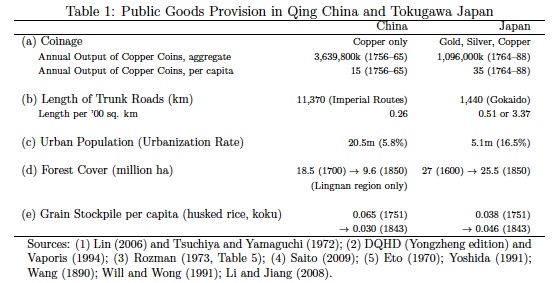
Therefore, according to Sng & Moriguchi, Meiji Japan and Republican China inherited the “governing infrastructures” of their predecessors :
Edit : Note to all people who apparently stop reading here. The preceding was my description of someone else’s analysis. I disagree with the preceding. I argue Japan’s disunity and China’s unity are implicated.
(1)
I don’t find differences in state capacity, defined as fiscal capacity, terribly convincing as an important element of the divergence between Chinese and Japanese fortunes in the second half the 19th century. I agree with Bin Wong. Even if late imperial China’s ability to generate revenue and supply services was declining after 1700, the Qing still managed to suppress not only the Taiping rebellion, one of the largest and bloodiest civil insurrections in human history, but also other revolts at roughly the same time (Nien, the Hui, Dungans). Even taking into account participation from the western powers, that speaks to an impressive mobilisation of support and resources despite being in the “decadent” phase.
At the end of 1860, the Qing emperor had fled north of the Great Wall from whence his ancestors had hailed ; the western powers had occupied and partly burnt his capital ; and bizarre pseudo-Christian cultist-revolutionaries had declared a new state in one of China’s most important cities, Nanjing. Yet within a year, the Qing were back. At the very least, the Qing state did not yet face an insurmountable “crisis of legitimacy” in a way they definitely faced after their defeat in war with the Japanese in 1894-95.
Contrast this with the situation in Japan after its forced opening to the West in 1858. The Tokugawa suppressed one rebellion after another, but within a decade the regime collapsed as more and more vassals defected from the shogunal banner. And most of those insurrections issued from the southwestern extremity of Japan. That’s where the rival feudal lords who would eventually overthrow the shoguns and restore the emperor originated.
The Qing comeback after the Taiping is consistent with the very long-run pattern we see in Chinese history. China, stereotypically, experienced “dynastic cycles” with both surging and decadent phases. But these cycles became less volatile over time. The closer we get to the present, “core” China experienced more time under unification than under fragmentation, even during peaks of warfare and violence :

(Source of the graphic: Ma 2011)
Sng & Moriguchi only show taxes up to 1850. But what happened to Qing taxes after the Taiping rebellion ? They rose. An earlier paper (Sng 2014) by one of the co-authors mentions this in passing, but attributes it to the decentralisation and quasi-federalism the Qing were compelled to practise after the Taiping war.
But in reality the Qing simply found other, more indirect sources of revenue. After 1850, they became much more reliant on customs duties as foreign commerce expanded :

[ Source : The Rise of Fiscal States: A Global History 1500-1914 ] Even in real terms, though not in per capita terms, state revenues in the twilight of the Qing were as high as at the peak of their consolidation in the early 18th century.
(2)
The problem with the fiscal capacity approach is it doesn’t explain the right facts about China and Japan. How ever else they may have differed, the most important difference between the late Qing and late Tokugawa when it came to adjusting to modernity, was that a substantial fraction of the elites in the latter was apparently ready, earlier, to embrace radical change in society.
The opponents of the Tokugawa policy of opening to the West were xenophobic and ostensibly conservative. But when the shoguns were actually overthrown and the emperor restored to (nominal) power, the new leaders were anything but conservative or traditionalist. More importantly, a disproportionate share of the Meiji imperial elites came from Japan’s periphery. (More on this below.)
China also had its own kind of imperial reassertion after the Taiping rebellion was crushed — the so-called Tongzhi Restoration. This has been interpreted quite variously over the decades in western historiography. In the 1950s, in the hands of John King Fairbank, the Tongzhi restoration became the standard-bearer of proto-westernisation. But a later generation saw it as the last gasp of neo-Confucian traditionalism. Also, because the Taiping were defeated with vital assistance from local, semi-private militias from Hunan and Anhui organised nominally in the name of the Qing, the reassertion of imperial power has even been seen as a precursor to the warlordism of the 1920s and 1930s. How ever you interpret it, the provincial Han elites eventually rallied to the cause of the Manchurian Qing and the result was quite unlike the Meiji restoration in Japan.
From an economic history point of view, maybe the best gauge of the political attitude between the end of the Taiping war and the Sino-Japanese war is the railway network. The Qing, or factions within the imperial government, would not permit their construction. It was not until after China’s defeat by modernised Japanese armed forces in the war of 1894-95 that the government changed course and tried, haphazardly, a more “Japanese” approach. From Chinese Economic Performance in the Long Run :
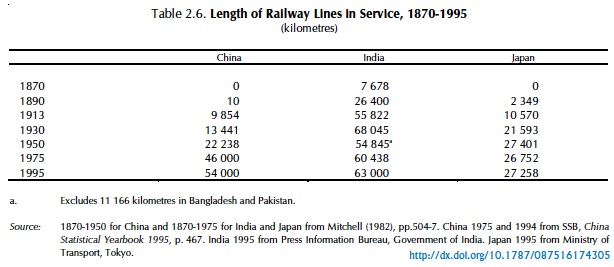
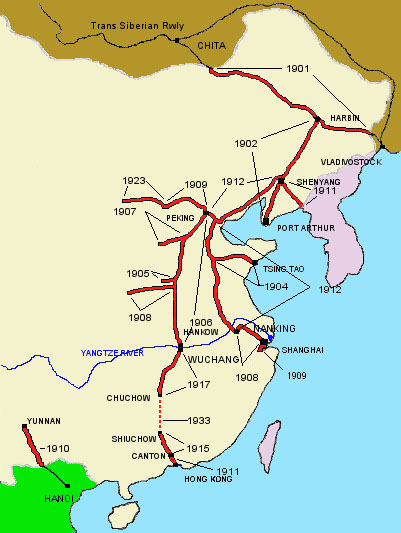
[railway map from Wikipedia]
But why this difference in elite attitudes in the mid-19th century ? I have no idea, but it must have something to do with Japan’s longstanding fractious feudalism and China’s tradition of centralised authority. The Tokugawa state even at its zenith was still “weak” in the sense of not having a monopoly on violence or even currency. From Jansen :
The aforementioned domains of Satsuma and Tosa, along with Choshu, overthrew the Tokugawa shogunate in 1868. The ancestors of these vassal clans (daimyo) and other rebel houses enfeoffed in the southwest of Japan had been defeated 268 years earlier in the civil war that put the Tokugawa in power. In other words, many of the very losers in that war remained in their autonomous redoubts and nursed their rivalrous grievances. The Tokugawa controlled them precariously and only with much effort. This is what the political patchwork of Tokugawa Japan looked like :
[Map also from Jansen. You can click to enlarge.] Fudai = “insider” or allies of the Tokugawa coalition which won the Battle of Sekigahara ; and Tozama = “outsiders” or the losers of that battle (or those who remained neutral and declared allegiance to the Tokugawa only after the battle).
(3)
The comparison of China and Japan also goes against the spirit of the “great divergence” scholarship of the last 20 years. Instead of comparing England or the Netherlands with China, historians began comparing single European countries or regions with commensurate “macro regions” in China, such as Lingnan or the Lower Yangzi.
The regional concept matters for “fiscal capacity” as well. Even if imperial China had always been a “low tax regime” compared with Europe, its taxing and spending would not have been uniform throughout the empire. So some of Sng & Moriguchi’s per capita public goods data may be misleading. As a general rule, empires behave differently toward core and periphery. Walter Scheidel, in a comparison of the Roman and Han fiscal regimes, argues they had different patterns of extraction but a more similar pattern of allocation. Rome under both the republic and the principate extracted revenue from its provinces, disproportionately via indirect sources, primarily in order to benefit the Italian heartland. The Han empire both taxed and spent in approximately the same place, the Yangzi valley region. For the Qing, there probably wasn’t much point in building roads in Gansu province (which is bigger than Japan) when most of the taxable peasants whose rice tribute they relied on inhabited the provinces of the Lower Yangzi.
An earlier paper (Sng 2014) by one of the co-authors does argue this very thing for Qing China. It uses the location of the imperial postal network and the prefectural seats to suggest the concentration of state activity. Of course the rulers of China were also keenly aware some regions of China were more prone to rebellion than others.
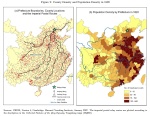 [Source: Sng 2014] [Source: Sng 2014] |
 [Source: Kung & Ma] [Source: Kung & Ma] |
(4)
In the final analysis, when you look at the Lower Yangzi macro region, you begin to think, this whole business of a big divergence between Japan and China is exaggerated. From “Economic Growth in the Lower Yangzi Region of China in 1911-37” :
Clearly, the region that had always been the most advanced in China, and the region that is right now amongst the most advanced, was already experiencing “modern” growth comparable with Japan in the interwar period. Japan’s headstart over China in per capita income probably preceded 1800, but the gap with the “Lower Yangzi Macro region” or even the combined Jiangsu-Zheijiang provinces in 1930 would surely have been much smaller, had the attitude of the Qing government or the provincial elites at the end of the 1860s been quite different. (You could make similar observations at more micro levels, e.g., in sericulture & silk textiles.)
Shanghai itself, as an international treaty port, was administered by a commission of western businessmen, complete with a western legal and institutional framework. How about outside Shanghai ? In the two decades prior to the Japanese invasion, just how much state capacity could have existed in the semi-governed environs of Shanghai ? Neither the republican regime in Nanjing nor the various warlords could have had as much “fiscal capacity” as the Japanese. Perhaps it was enough that the region was just a bit more more peaceful than the rest of China, at least before the Japanese invasion.
Edit: I have already heard nitpickings on Twitter that I underplay the Western intervention in the Taiping war (including “Chinese” Gordon and the American Frederick Townsend Ward) ; and overplay the provincial rallying to the Qing… But the fact remains, the Hunan Army, which took the Taiping capital of Nanjing, was not controlled by Beijing yet was disbanded by its leader. He might have attempted a seizure of power in the capital, yet submitted to the Qing. The Anhui army was not disbanded, but its leader became an important Qing official who would later suppress the Nian rebellion.
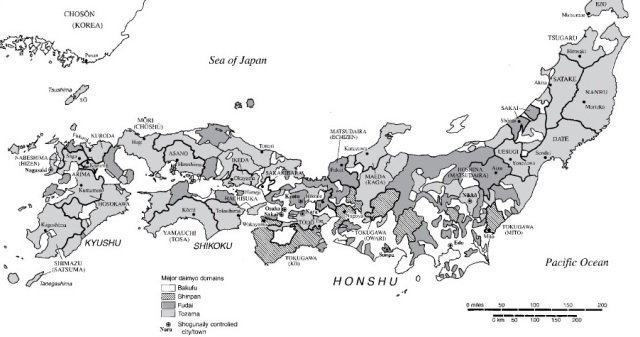


Pingback: Thursday assorted links
There is one glaring error in this analysis – maybe more. Tokogawa Japan was not interested in infrastructure improvements – quite the opposite. When the Shogunate was imposed in the early seventeenth century the Shogunate tore down bridges and discouraged horse travel. Roads were left to deteriorate. The authors assume that the check on beneficial public works was the ability to collect taxes. Not so.
LikeLike
I’m currently doing my master-thesis on the Meiji-revolution, and have studied this subject deeply. Actually, the building and maintaining of roads was one of the few things the Tokugawa were very keen on doing. The structure of government was very different from a western nation-state, but I can assure you, building roads was one of their pet peeves. They had supervisors everywhere to make sure the han maintained them well.
LikeLike
Well, that’s not my analysis, it’s the analysis belonging to Sng & Moriguchi that I dispute in this post.
However, you overlook one thing : the “alternate attendance” system (sankin kotai) enforced by the Tokugawa on the daimyo is usually credited with the development of roads. The daimyo had to go back and forth between the capital and their regional seats with huge retinues.
LikeLike
Pingback: Thursday assorted links | Homines Economici
What about trust as a resource? Were there sociological differences that separate the Ottoman, Chinese and Egyptians from the Japanese as a culture, such that economic and social friction was qualitatively different?
LikeLike
Mr. Boyle is correct. The Tokugawa were hostile to infrastructure improvements and spent essentially no state revenues on building roads, harbors, bridges – with the lone exception of the one road from Osaka to Edo (Tokyo). Further, the Tokugawa did not collect taxes across all of Japan, they only (?) collected taxes in their relatively modest personal domain. Tokugawa Japan is not at all similar in governmental structure to Qing China. It is perhaps most akin to Greece during the years of Macedonian glory – Athens, Sparta, Thebes, Corinth – all nominally allied to Macedon, each ready to fight under certain conditions.
I argue that Japan under the Satsuma/Chosun regime was the first real unified government Japan in hundreds of years.
N.B. The Meiji restoration was a fiction. The Meiji emperor was allowed no say in government. The real rulers were entirely drawn from upper level samurai of Satsuma, Chosun and, occasionally Tosa.
LikeLike
Colin, so you agree with me, then.
The first part of this post is my description of the argument by Sng & Moriguchi, which I go on to dispute, even to the point of mentioning that Japan was fractiously feudal & disunited whilst China was usually united ; and that Satsuma, Choshu, etc. supplied the disproportionate part of the Meiji imperial elite.
LikeLike
Excellent.
Post 1880 the Japanese were better at mobilizing savings for industrial expansion under the auspices of the State. China didn’t really have a State capable of sponsoring Industrialisation till 1950.
LikeLike
I would have thought the situation quite clear: Tokugawa collapse, new elite that has significant foreign experience historically decides to bring in Westernisation. Westernisation is a founding principle of Meiji Japan. Qing was like Tokugawa Japan, based on different principles, unable, unwilling to change. The new republic that was established lacked control over the country and clarity of aims. It also brought in massive Westernisation but since it tried to pander to many domestic interest groups, created a hybrid Chinese-Western culture. Its failures were political and economic rather than social.
LikeLike
But at the end I argued that interwar Republican China, at least in the lower Yangzi, performed not too shabbily compared with Japan. The point : the Sino-Japanese divergence is exaggerated, and largely a function of comparing all of China with Japan.
LikeLike
“Why China did not industrialise before Western Europe may be a tantalising and irresistible subject, but frankly it’s a parlour game.” No, the theory of the high-level equilibrium trap answers well and fully, and is more than guesswork. Ya’ think it may also answer why Japan and not China industrialized (American spelling) as well?
LikeLike
No, because HLET almost certainly applied to Japan as well.
In the past 15 years, Elvin’s “high-level equilibrium trap” has gotten a new lease on life. Expanded upon, more evidence. Have been meaning to post something about it.
LikeLike
Please do
LikeLike
I don’t know that HLET almost certainly applied to Japan as well: the decline of the samurai class in cultural influence and prosperity as the merchant classes from Edo and Osaka (especially sake brewers) rose in stead; the amount of capital swashing around for investment in technical improvements whereas in China even the spinning wheel which was ubiquitous for some time in the Ming was in disuse and monies were sunk into passing the examination system or public works by the landed gentry.
LikeLike
In one sense, by saying that the most active parts of China did not lag all of Japan so much, are you not agreeing with the China-was-too-big theory? I think Braudel in The Perspective of the World made the same point (or at least asked it) regarding France: Was it too big and therefore administratively too stressed and economically too unfocused to complete successfully for European hegemonic succession. France was wealthy enough, but that wasn’t enough. It’s almost like size is a disadvantage until you have industrialized and implemented fast communications; then it’s an advantage.
LikeLike
I completely agree with the geological differences in terms of size. My dissertation is on Anglo-Japanese relation and I am a Chinese myself, I can answer with certainty that the efficiency of administrative communication, the level of involvement of the highest ranking officials in particular matters are most certainly different. Karl Popper was right to warn us the danger of thinking too much on the macrohistory level. The divergence on China and Japan could be simply explained by the differences in the handling of each single matter, done to factory. Japan, as a smaller country, simply did better, faster and maneuvered with better control.
LikeLike
I realy wonder how “western Imperialism” is to blame for Imperial Chinas unwillingness to modernize…..If anything by showing them in war after war how inferior they were to the west it actualy forced them to understand that traditional ways wernt the way to go.
If one looks at Chinas trade in the second half of the 19th century one can see that the country well got the money and rescourses to start a japan style modernisation and the fact that they didnt, instead limiting it to the “self-strengthening movement” cant be blamed on lower taxes or “western imperialism” but rather on simple stuborness and unwilingness of the elites and I cant understand how the autors of this paper could ignore this.
Instead they give 2 reasons for China not modernizing: “western imperialism” and low taxes while ignoring the elefant in the room namly to modernize you first need to WANT it…….Its like saying that I didnt go to the supermarket yesterday because 1.I didnt have feet and 2.didnt have eyes to see the way instead of asking if I even wanted to go there…..
As for Japan, I wonder when they would have started modernizing/westernizing were it not for “western imperialisms” “gently” (or not so gentle) pushes in the 1850-1860s, but no if Japan modernizes its the brave Japanese themselves doing it, if China dosnt modernize its “western imperialisms” fault.
I think the huge sucsesses of the Nationalist in the 1930s (coal, Iron and steel production increased massivly, several types of Industry were created from scratch, a stable financial system created, Infrastructure and education massivly improved) while faced with: 1.the great depression which made foreign investment very limited, 2.Warlords, Communists and Japanese, who forced the government to keep a far to large army and kept most of China in a state of war or instability or warlord mismanegment and 3. a lack of educated specialists and no money to hire westerners (see great depression, the Japanese had it far easier with this in the 1880s) and massive corruptions, clearly show what the Chinese were capeble of if led by a government that has Modernisation/westernisation as its goal (The Nationalists showed later what they were capeble of in Taiwan). The Qing could have done all this and more had they just wanted and right now we would already have a world dominated by China not just one were Chinese domination seems posible.
Why do so many economists ignore human will as a factor and think that what hapened couldnt have hapened any other way?
Sorry for my bad English.
LikeLike
China being less prone to westernize than Japan makes sense. Japan as located in the periphery of the civilization has a history of integrating foreign influences, be it Chinese Korean or Indian, so accepting western influence posted less psychological burden to them. China on the other hand had been seeing itself as the center of the world for millenniums, and was kinda justified in thinking so given the climates or terrains of surrounding regions (Sinkiang, Mongolia, Manchuria and the Zomia) being less suitable for intensive agricultural states and further upperstructure formation. So for them it needed to overcome more serious psychological barrier to whole-heartedly embrace westernization.
Still, just keep in mind that the west was are is still well aware of the fact that a modernized China is far greater a threat than Japan.
LikeLike